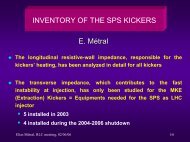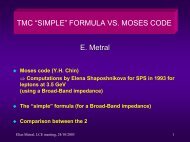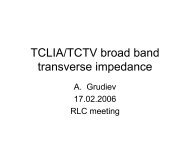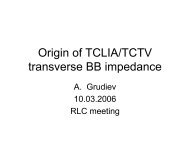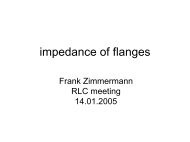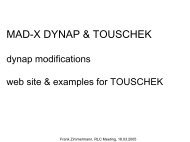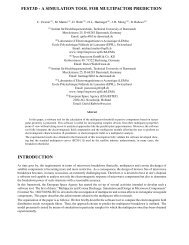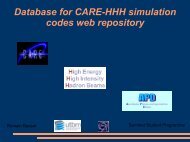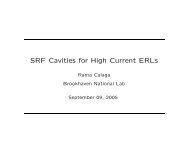Photoionization Cross Sections of He and H2
Photoionization Cross Sections of He and H2
Photoionization Cross Sections of He and H2
Create successful ePaper yourself
Turn your PDF publications into a flip-book with our unique Google optimized e-Paper software.
PHOTOIONIZATION CROSS SECTIONS OF <strong>He</strong> AND H 2<br />
1045<br />
TABLE 1<br />
HELIUM SUM RULES<br />
Sum Rule Exact Discrete 24.6È280 eV Resonances 0.28È2 keV 2È8 keV 8ÈO keV Total<br />
(1) (2) (3) (4) (5) (6) (7) (8) (9)<br />
S([2).......... 1.3832 0.6495 0.7267 0.0027 0.0001 . . . . . . 1.379<br />
S([1).......... 1.5050 0.5234 0.9678 0.0063 0.0015 . . . . . . 1.499<br />
S(0) ............ 2 0.4229 1.5242 0.0147 0.025 . . . . . . 1.987<br />
S(1) ............ 4.0837 0.3426 3.179 0.034 0.3996 0.03395 0.006 3.995<br />
S(2) ............ 30.33 0.28 9.853 0.08 9.035 4.396 5.686 29.33<br />
S(2)ln 2K ...... 111.5 [0.06 13.21 0.08 29.54 21.71 44.46 108.9<br />
where k \[0.012 is the limiting value <strong>of</strong> the quantum<br />
defect for the 1P series. Their contributions to the individual<br />
sums are given in column (3) <strong>of</strong> Table 1. The discrete oscillator<br />
strengths sum to 0.4229, in satisfactory agreement<br />
with an experimentally derived sum <strong>of</strong> 0.431 ^ 0.02 (Chan<br />
et al. 1991).<br />
From the continuity <strong>of</strong> the oscillator strength across the<br />
ionization threshold, we obtain from equation (11) a value<br />
<strong>of</strong> 1.84 for df/dv at the spectral head, corresponding to a<br />
threshold photoionization cross section <strong>of</strong> 7.42 ] 10~18<br />
cm2 at a photon energy <strong>of</strong> 24.587 eV. The value is in close<br />
agreement with several theoretical calculations <strong>and</strong> experimental<br />
measurements (Samson et al. 1994b). Samson et al.<br />
(1994b) recommend a threshold cross section <strong>of</strong><br />
7.40 ] 10~18 cm2, <strong>and</strong> Bizau & Wuilleumier (1995) recommend<br />
7.42 ] 10~18 cm2.<br />
Reliable measurements exist for photon energies up to<br />
120 eV. Samson et al. (1994b) <strong>and</strong> Bizau & Wuilleumier<br />
(1995) extended them to 280 eV with an extrapolation based<br />
on several earlier sources <strong>of</strong> experimental data. The recommended<br />
values are listed in Table 2. They are in satisfactory<br />
agreement with theoretical calculations (Bell & Kingston<br />
1971; Hino et al. 1993; Meyer & Greene 1994; Decleva,<br />
Lisini, & Venuti 1994; Tang & Shimamura 1995; Pont &<br />
Shakeshaft 1995; Venuti, Decleva, & Lisini 1996). We list in<br />
column (4) <strong>of</strong> Table 1 the contributions to the sum rules. In<br />
the same energy region are absorptions into doubly excited<br />
resonance states (nsmp), which introduce structural features<br />
into the variation <strong>of</strong> the cross section with photon energy.<br />
Although resonance parameters, energy, width, <strong>and</strong> proÐle<br />
have been calculated by a number <strong>of</strong> investigators (Ho<br />
1995; Venuti et al. 1996; Sadeghpour & Cavagnero 1993;<br />
Sanchez & Martin 1991; Tang et al. 1992), explicit values<br />
for the resonant contributions to di†erent oscillator sum<br />
rules have not been available. A recent calculation<br />
(Sadeghpour 1998) shows that they contribute negligibly for<br />
m º 5 <strong>and</strong> n º 6. The doubly excited state contributions to<br />
the sum rules obtained by integrating over the calculated<br />
resonance proÐles are given in column (5) <strong>of</strong> Table 1. With<br />
their inclusion, the sum rules S([2) <strong>and</strong> S([1) to which<br />
higher energies yield negligible amounts are satisÐed to<br />
within 0.5%.<br />
The photoionization cross sections at higher energies are<br />
less certain. The measurements may be a†ected by the presence<br />
<strong>of</strong> impurities in the gas <strong>and</strong>, at energies above 1.5 keV,<br />
by Compton ionization (McCrary, Looney, & Atwater<br />
1970; Samson, Greene, & Bartlett 1993; Samson et al.<br />
1994a; see also ° 5). From a review <strong>of</strong> the theoretical <strong>and</strong><br />
experimental data, Samson et al. (1994b) have constructed a<br />
set <strong>of</strong> photoionization cross sections at energies between<br />
280 eV <strong>and</strong> 8 keV. Subsequently, several calculations <strong>of</strong> the<br />
cross sections have been reported (Hino 1993; Andersson &<br />
Burgdoerfer 1993; Forrey et al. 1997) using di†erent<br />
methods. The calculations are consistent with the limiting<br />
nonrelativistic form,<br />
df<br />
dv D 21@2Z2S(2) E~7@2 (12)<br />
n<br />
(Kabir & Salpeter 1957; Dalgarno & Stewart 1960), which,<br />
on using the value <strong>of</strong> S(2) in Table 1 <strong>and</strong> converting from<br />
atomic units, becomes, for the photoionization cross<br />
section,<br />
p(E) D 733.0 barns . (13)<br />
E(keV)7@2<br />
We constructed a set <strong>of</strong> cross sections by merging the highenergy<br />
data <strong>of</strong> Andersson & Burgdoerfer (1993) <strong>and</strong> Forrey<br />
et al. (1997), computed in the acceleration gauge, with the<br />
low-energy results <strong>of</strong> Samson et al. (1994b). The corresponding<br />
contributions to the sum rules are listed in<br />
columns (6), (7), <strong>and</strong> (8) <strong>of</strong> Table 1 for energies between 280<br />
eV <strong>and</strong> 2 keV, 2 <strong>and</strong> 8 keV, <strong>and</strong> greater than 8 keV, respectively.<br />
The sums <strong>of</strong> all the contributions are given in column (9).<br />
There are di†erences <strong>of</strong> up to 3% from the exact values that<br />
can be sensibly remedied only by increasing the cross sections<br />
in the lower energy region between 170 eV <strong>and</strong> 2 keV.<br />
We modiÐed them accordingly so that a smoothly varying<br />
cross section results. It is illustrated in Figure 1 as the<br />
product <strong>of</strong> E7@2p(E) with E in units <strong>of</strong> the ionization poten-<br />
<strong>Cross</strong> Section (barn)*(Energy/I th<br />
) 7/2<br />
10 9<br />
10 8<br />
10 7<br />
<strong>He</strong><br />
H<br />
10 6<br />
10 0 10 1 10 2 10 3 10 4<br />
Energy/I th<br />
FIG. 1.ÈRecommended photoionization cross sections in the form<br />
(E/I )7@2p(E), where I is the respective ionization potential for H, <strong>He</strong>, <strong>and</strong><br />
H . th<br />
Also shown is 2 ] th<br />
the hydrogen cross section.<br />
2<br />
2H<br />
H 2



